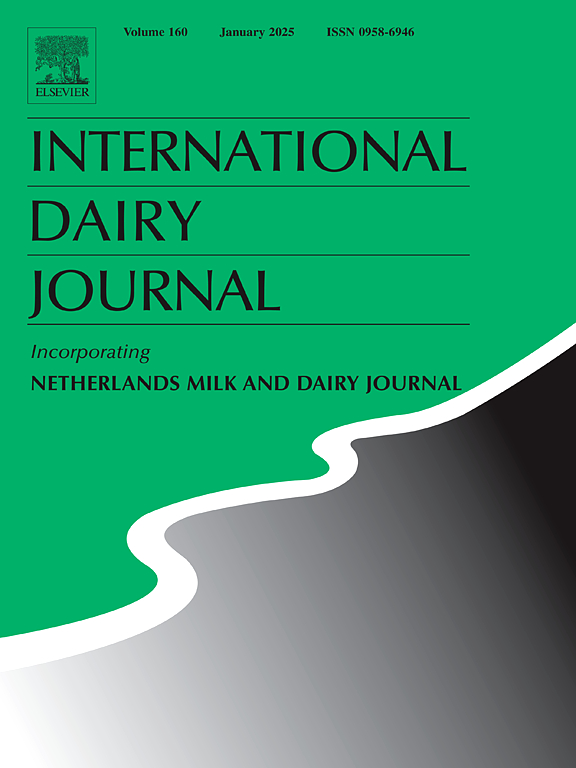Bioactive potentials of paraprobiotic kefir: Enhanced protein hydrolysis and anticancer efficacy
IF 3.1
3区 农林科学
Q2 FOOD SCIENCE & TECHNOLOGY
引用次数: 0
Abstract
Recent research highlights paraprobiotics and postbiotics as viable alternatives to probiotics. This study examined kefir prepared with probiotics (Lacticaseibacillus casei 39) and paraprobiotics (autoclaved L. casei 39 cells), evaluating their physicochemical, microbiological, and bioactive properties. Paraprobiotic addition did not alter kefir composition. During 28-day storage, Lactobacillus spp. levels decreased in all kefirs but remained higher in probiotic kefir, maintaining L. casei 39 at 10⁸ CFU mL−1. Notably, paraprobiotic kefir exhibited the highest protein hydrolysis degree (76.8%) following in vitro gastrointestinal digestion (P < 0.05). SDS-PAGE analysis of paraprobiotic kefir showed more intense bands for casein and β-lactoglobulin. Although antioxidant activity was similar across samples, probiotic kefir exhibited the strongest α-glucosidase inhibition (P < 0.05). Notably, paraprobiotic kefir displayed the highest anticancer activity against HT29 colon cancer cells (P < 0.05). These results suggest paraprobiotics as effective functional food components, offering comparable or enhanced bioactivity, improved stability, and easier production than traditional probiotics.
副益生菌开菲尔的生物活性潜力:增强蛋白质水解和抗癌功效
最近的研究强调了益生菌和后益生菌作为益生菌的可行替代品。本研究考察了益生菌(干酪乳杆菌39)和副益生菌(热压干酪乳杆菌39细胞)制备的开菲尔,评估了它们的理化、微生物学和生物活性特性。添加副益生菌不会改变开菲尔的成分。在28天的储存过程中,乳杆菌在所有开非尔中的水平均有所下降,但在益生菌开非尔中仍保持较高水平,在10⁸CFU mL - 1时维持干酪乳杆菌39的水平。值得注意的是,体外胃肠道消化后,副益生菌开菲尔的蛋白质水解度最高(76.8%)。0.05)。SDS-PAGE分析显示,副益生菌开菲尔的酪蛋白和β-乳球蛋白条带较强。虽然不同样品的抗氧化活性相似,但益生菌开菲尔表现出最强的α-葡萄糖苷酶抑制(P <;0.05)。值得注意的是,副益生菌克非尔对HT29结肠癌细胞的抗癌活性最高(P <;0.05)。这些结果表明,与传统益生菌相比,副益生菌是一种有效的功能性食品成分,具有相当或更高的生物活性,更好的稳定性,更容易生产。
本文章由计算机程序翻译,如有差异,请以英文原文为准。
求助全文
约1分钟内获得全文
求助全文
来源期刊

International Dairy Journal
工程技术-食品科技
CiteScore
6.50
自引率
9.70%
发文量
200
审稿时长
49 days
期刊介绍:
The International Dairy Journal publishes significant advancements in dairy science and technology in the form of research articles and critical reviews that are of relevance to the broader international dairy community. Within this scope, research on the science and technology of milk and dairy products and the nutritional and health aspects of dairy foods are included; the journal pays particular attention to applied research and its interface with the dairy industry.
The journal''s coverage includes the following, where directly applicable to dairy science and technology:
• Chemistry and physico-chemical properties of milk constituents
• Microbiology, food safety, enzymology, biotechnology
• Processing and engineering
• Emulsion science, food structure, and texture
• Raw material quality and effect on relevant products
• Flavour and off-flavour development
• Technological functionality and applications of dairy ingredients
• Sensory and consumer sciences
• Nutrition and substantiation of human health implications of milk components or dairy products
International Dairy Journal does not publish papers related to milk production, animal health and other aspects of on-farm milk production unless there is a clear relationship to dairy technology, human health or final product quality.
 求助内容:
求助内容: 应助结果提醒方式:
应助结果提醒方式:


